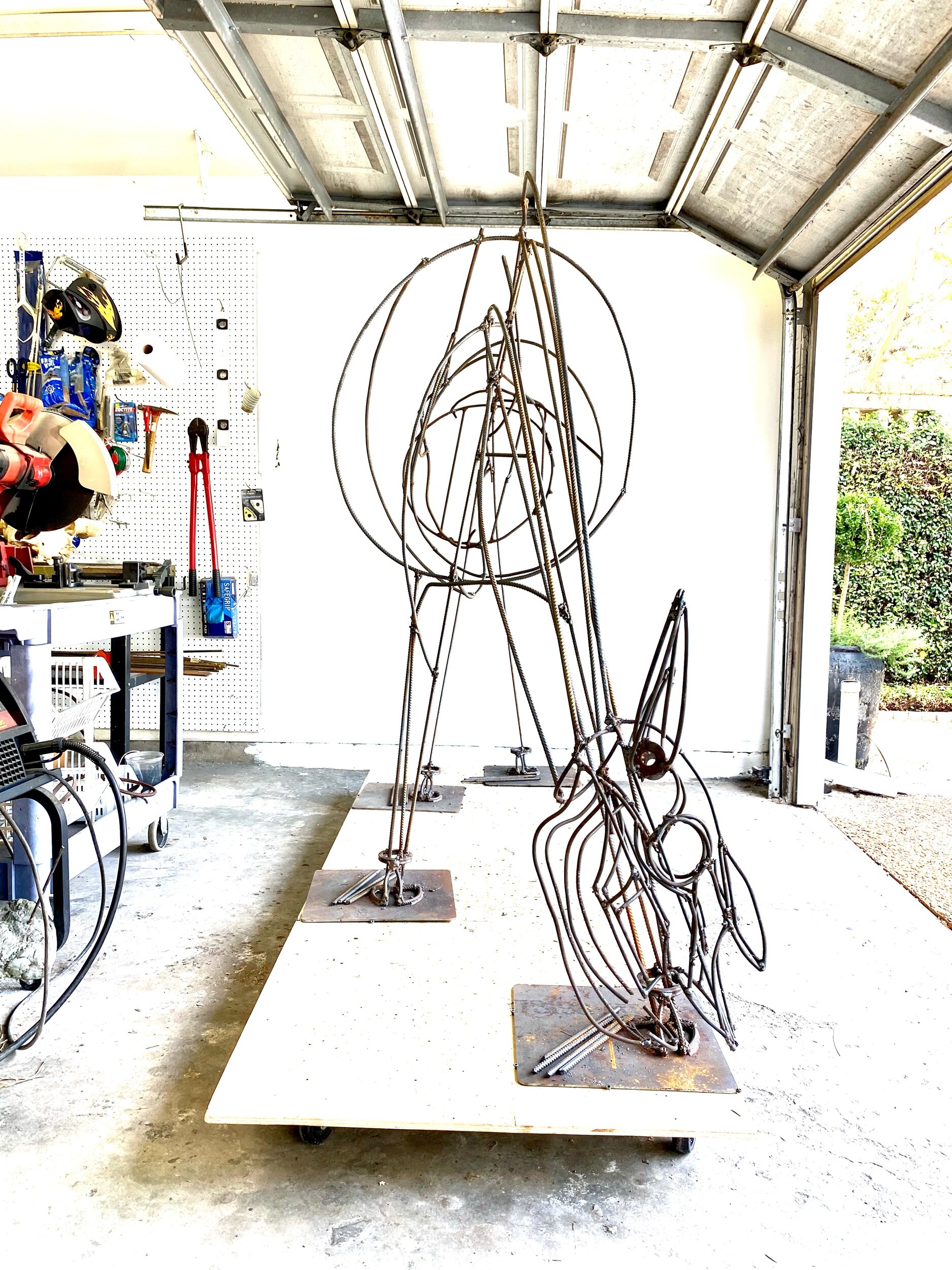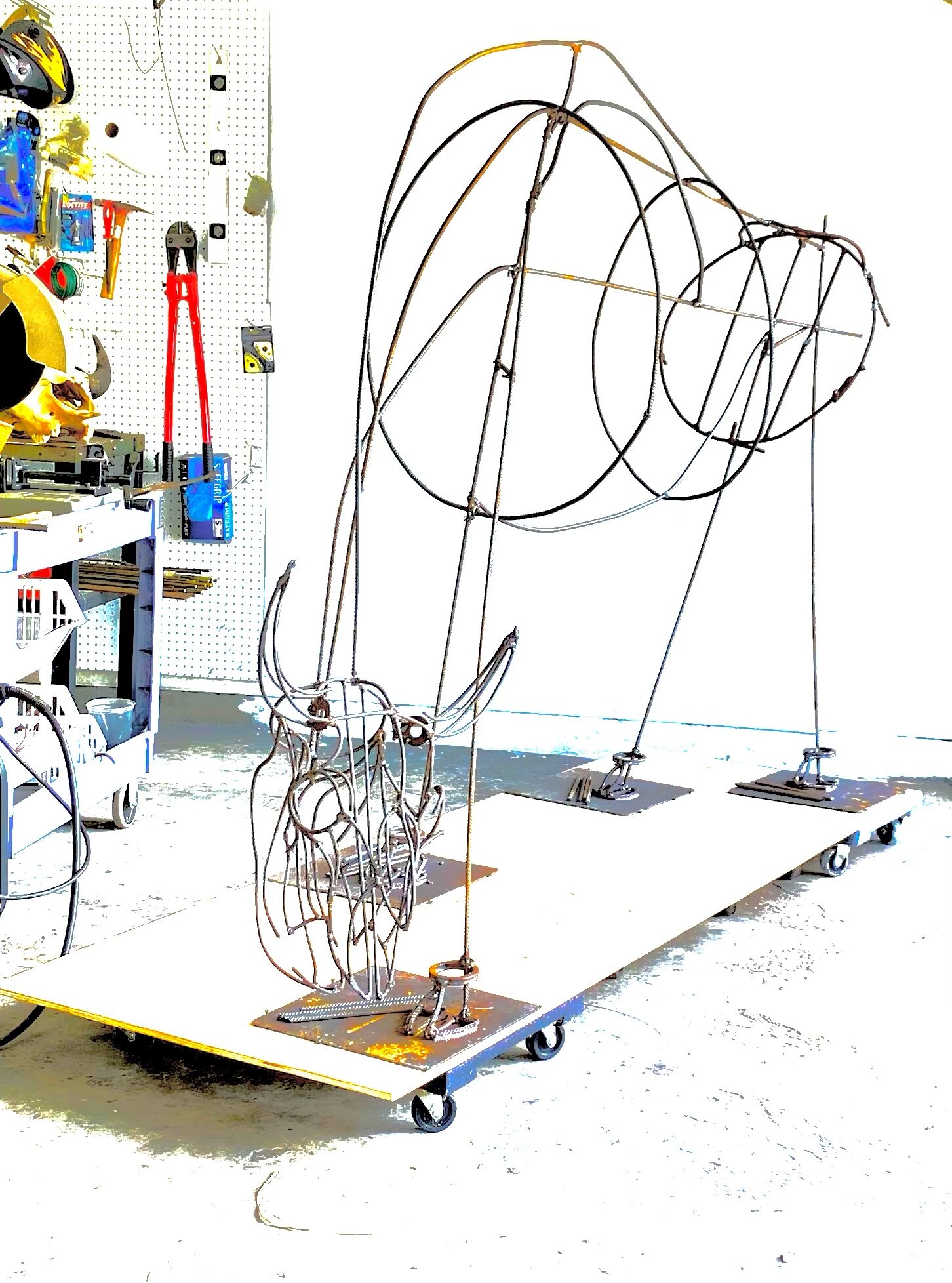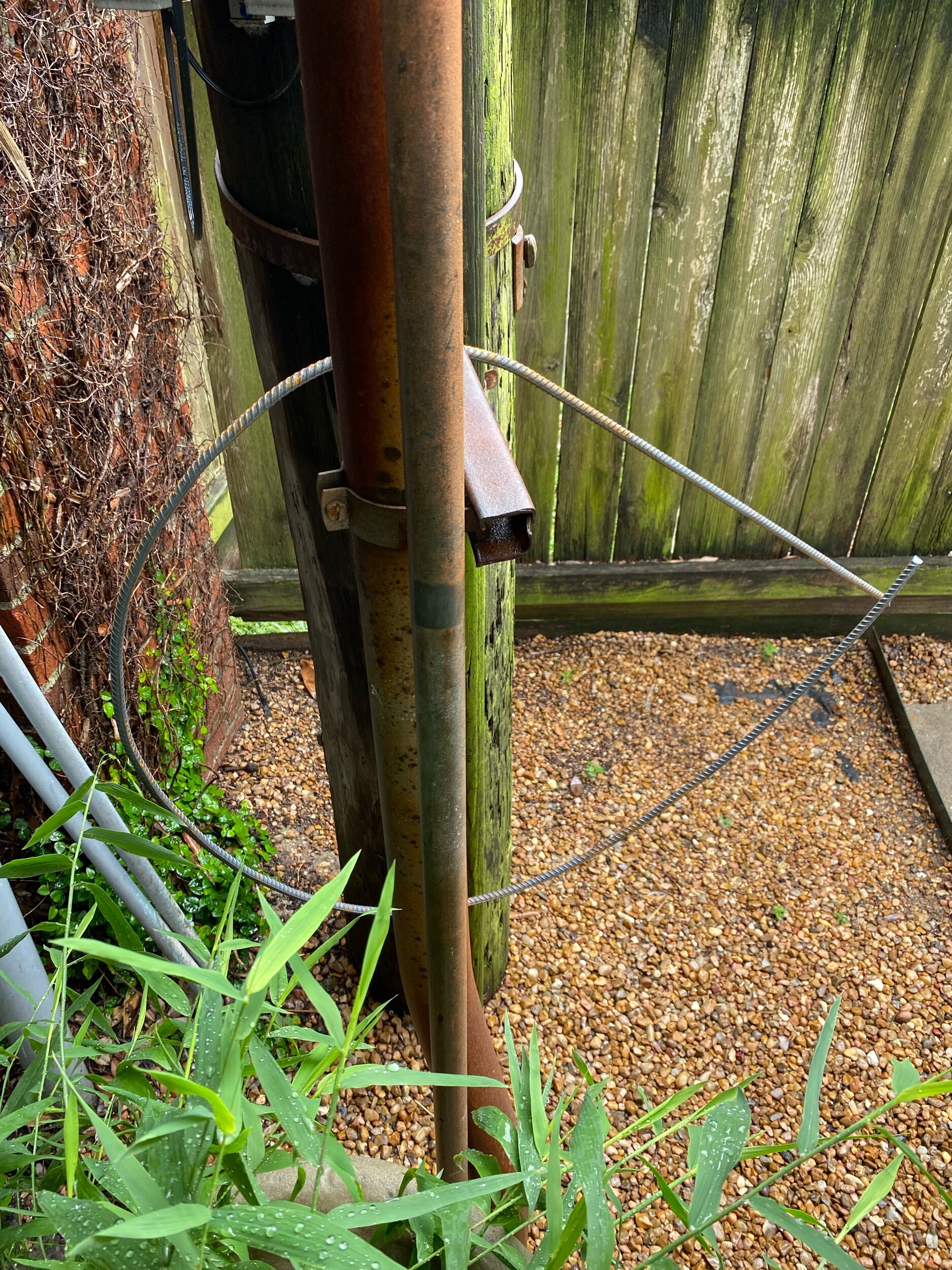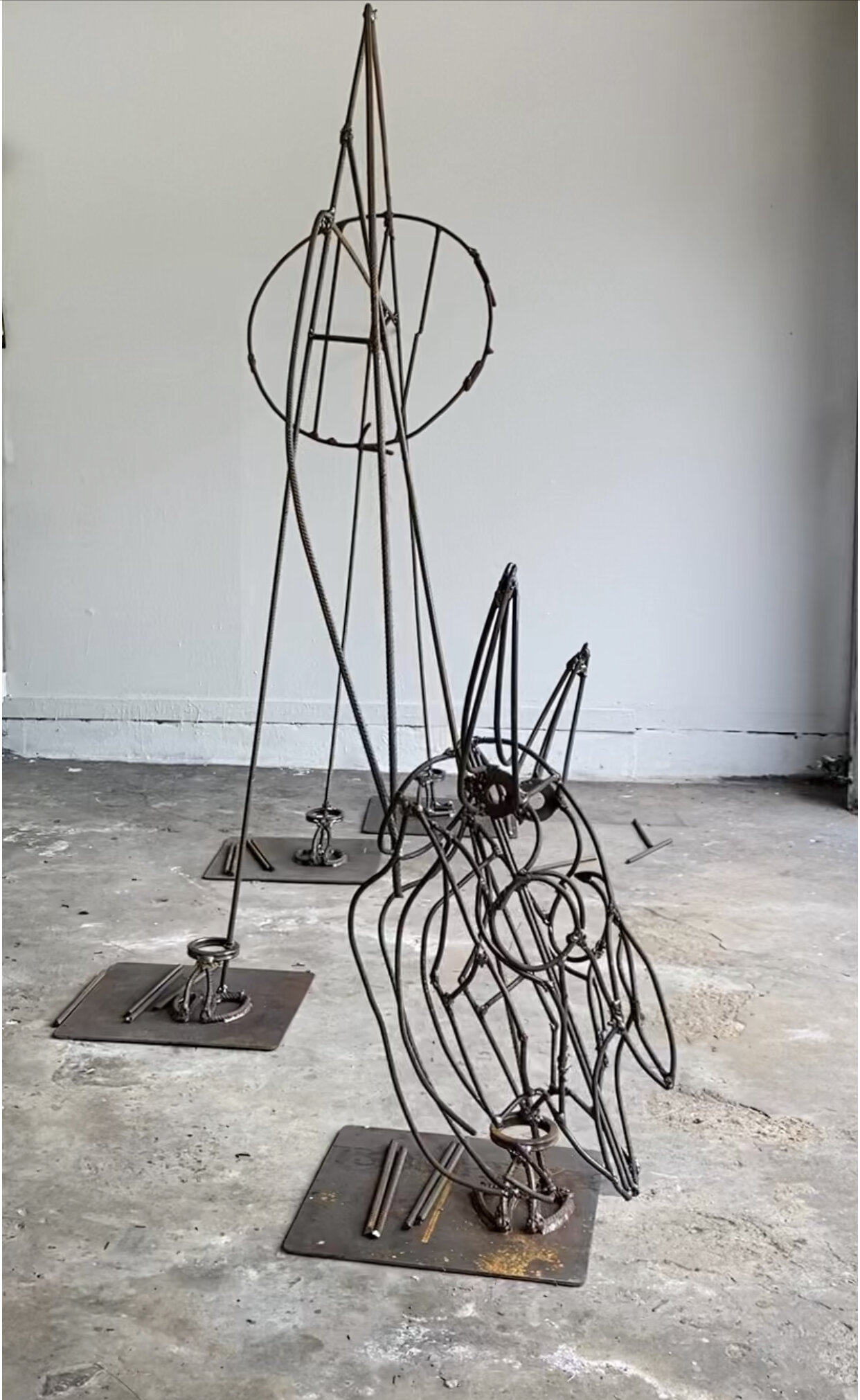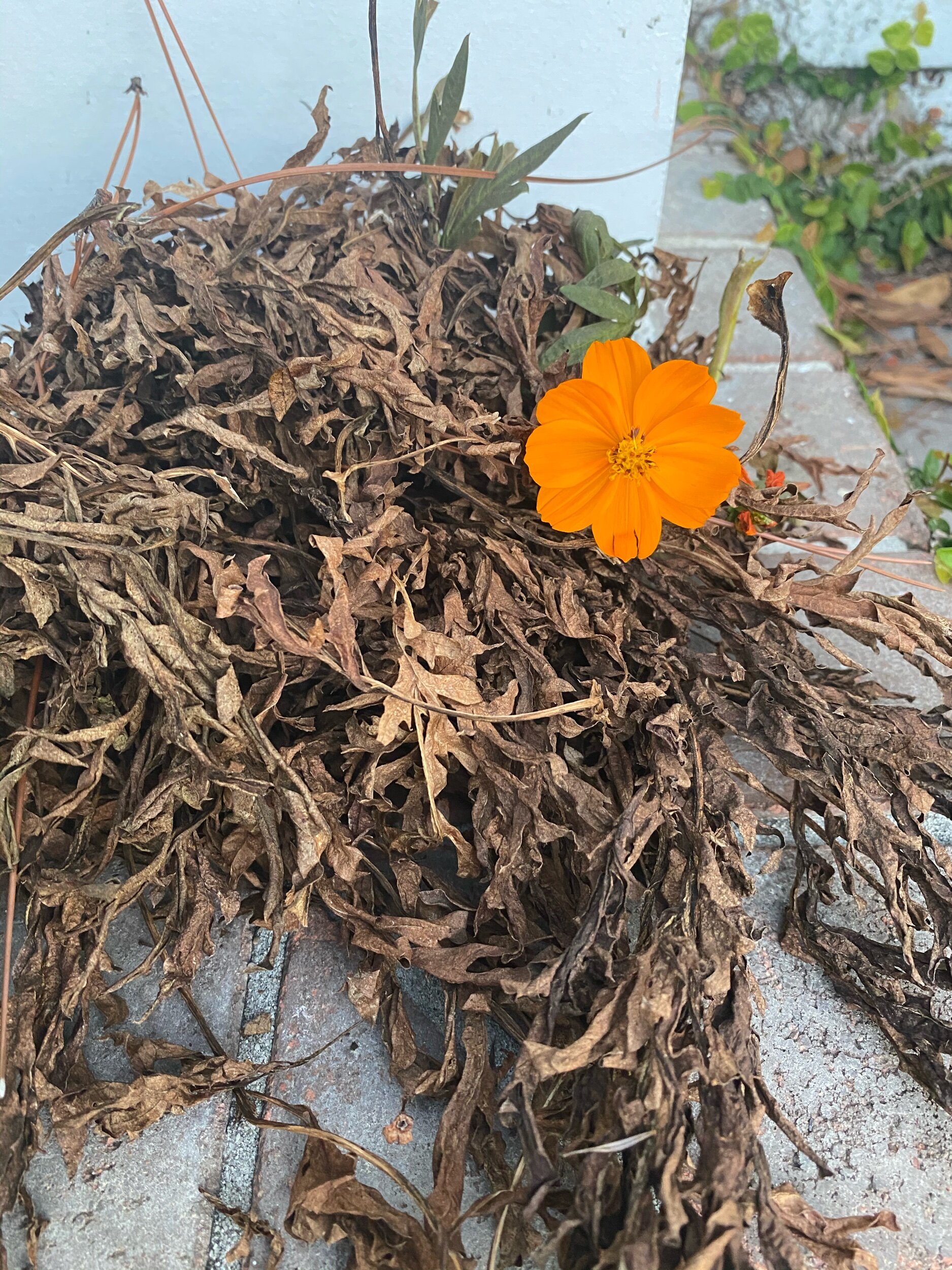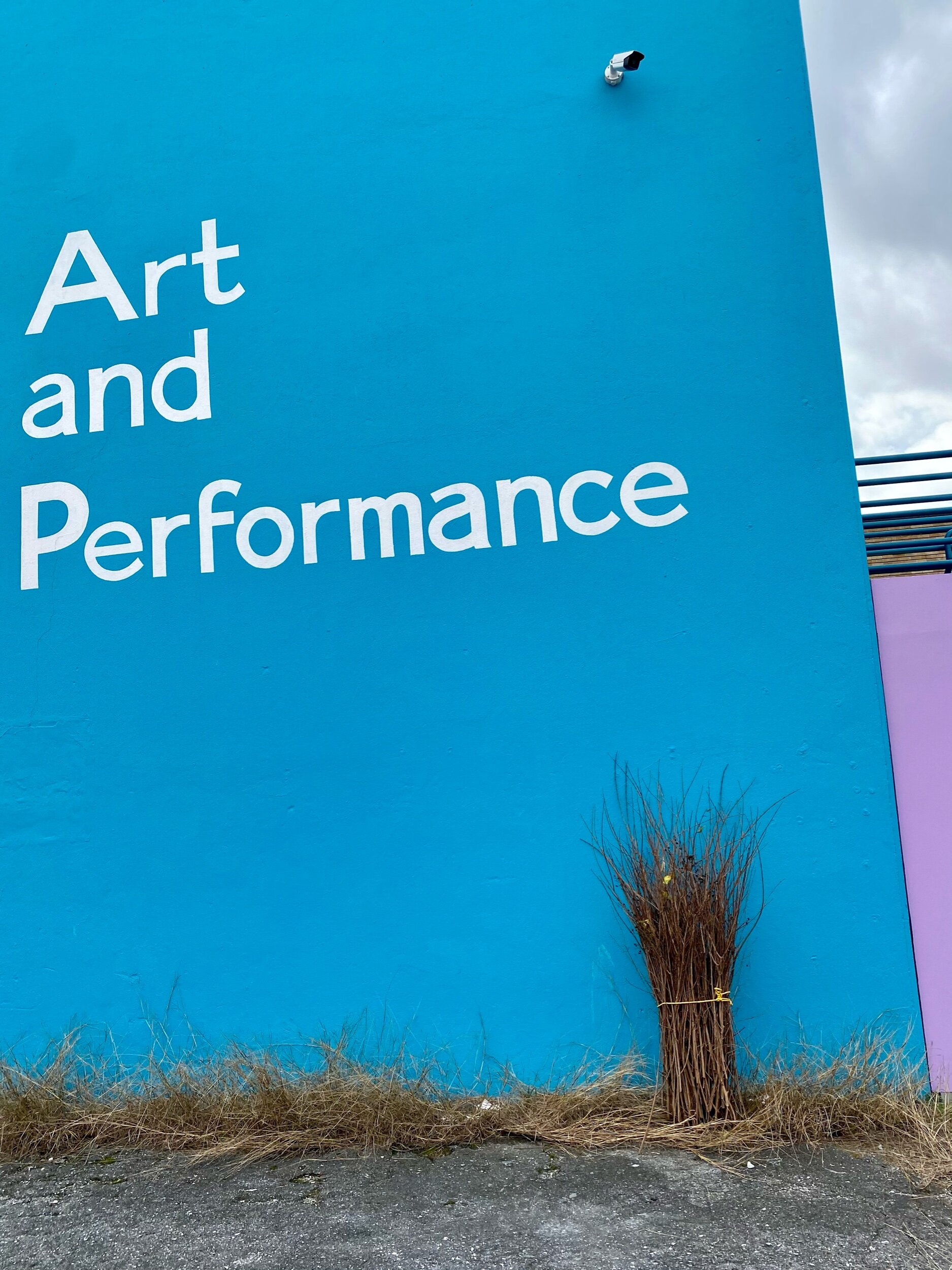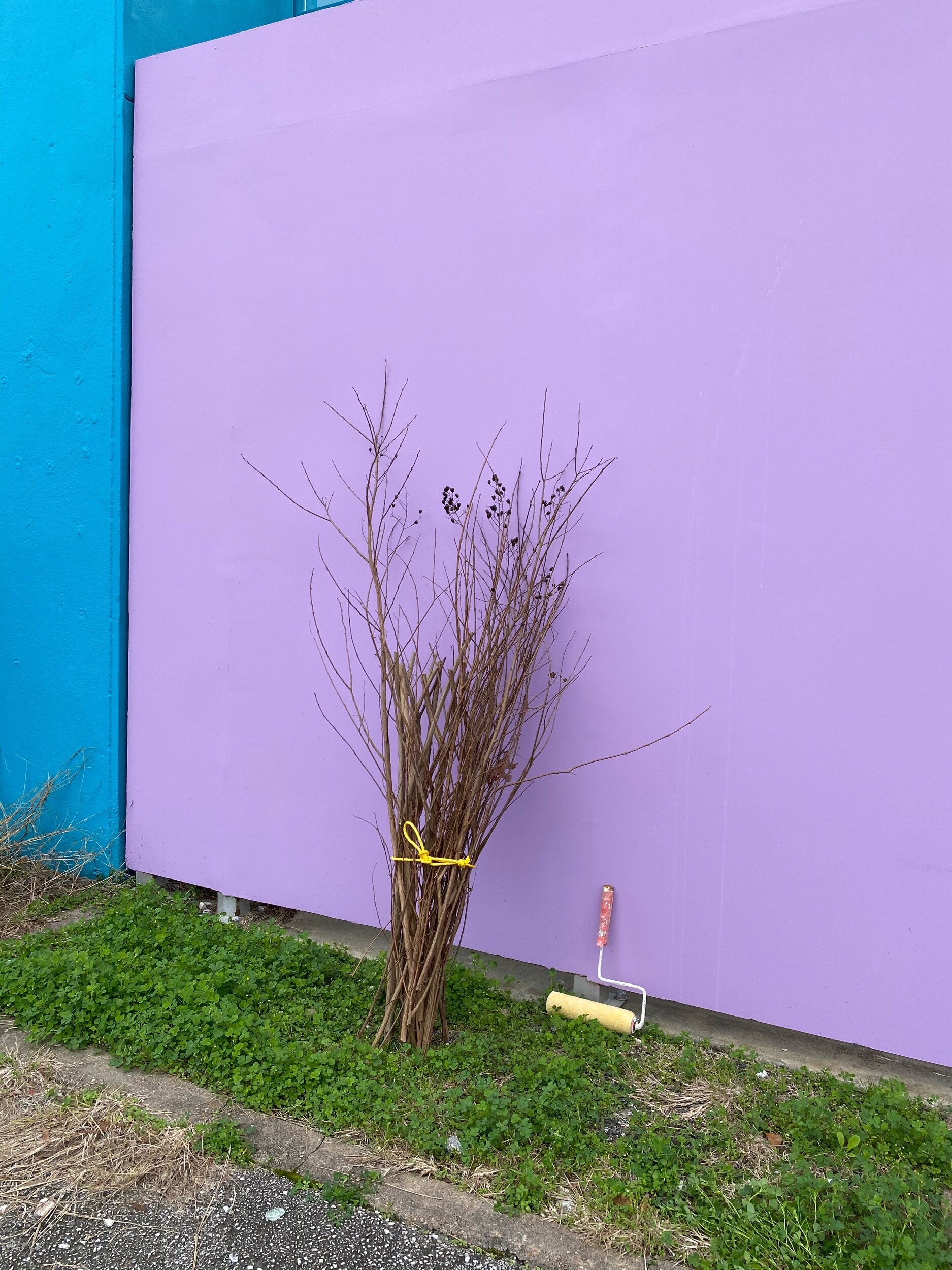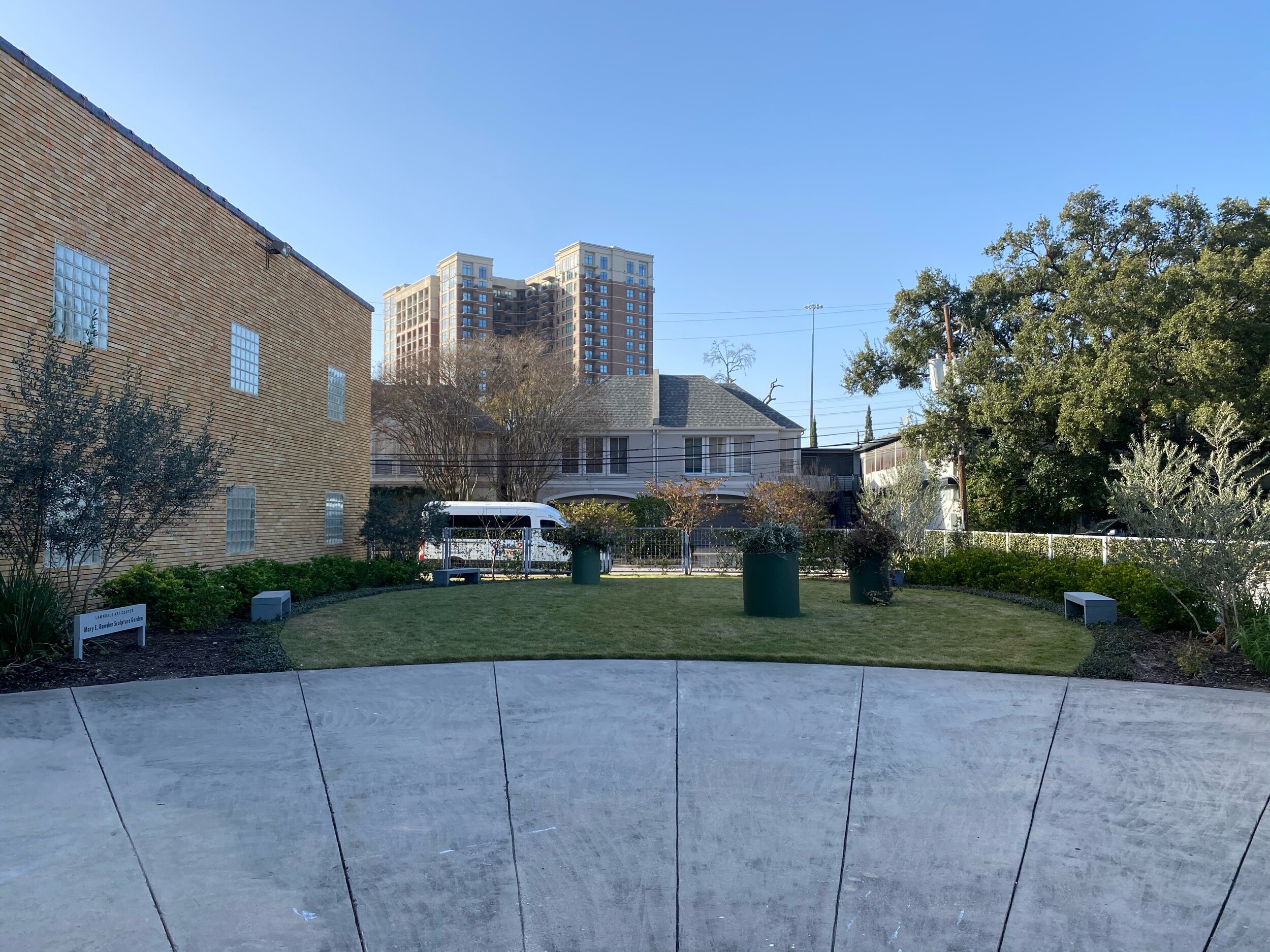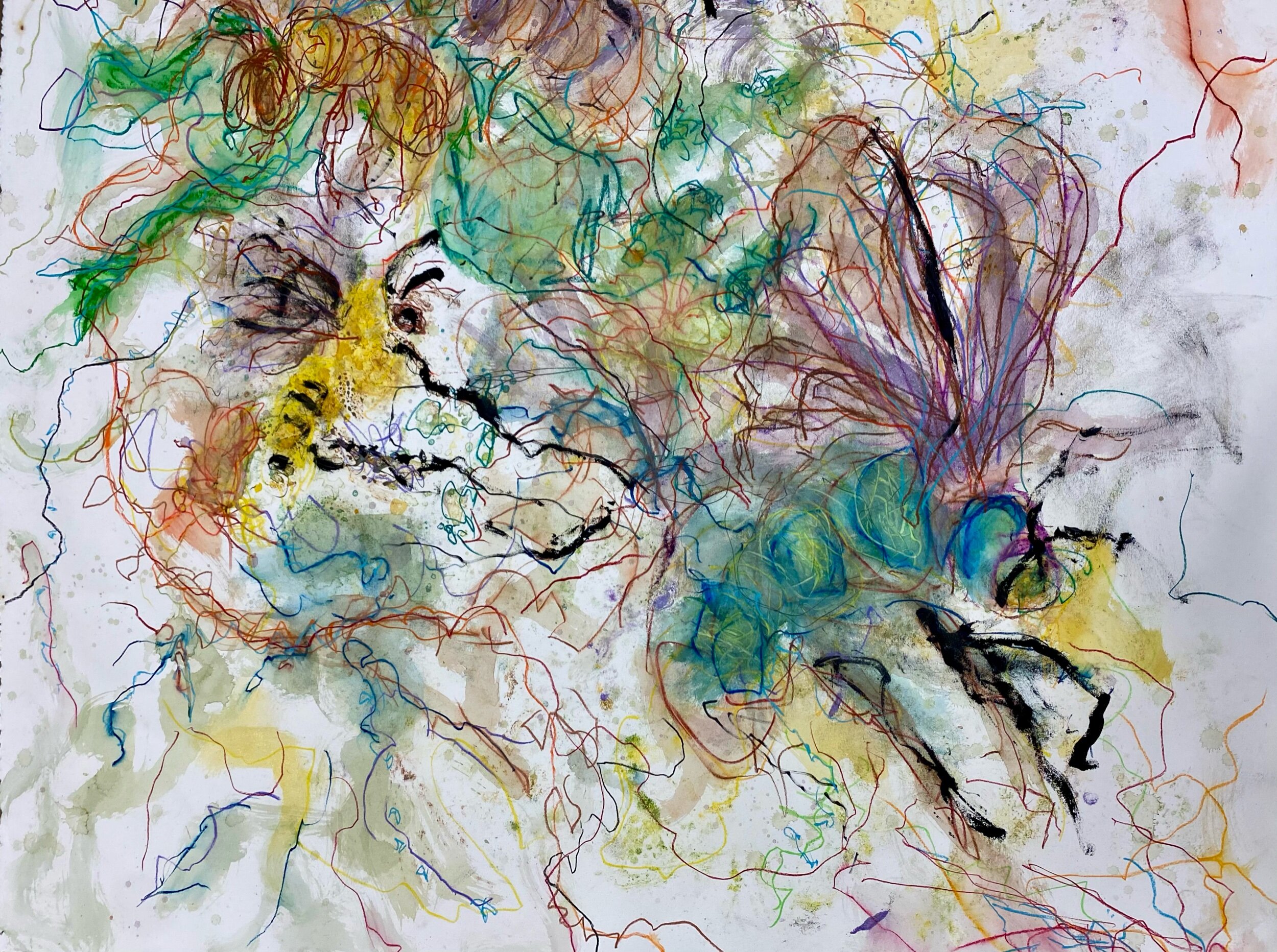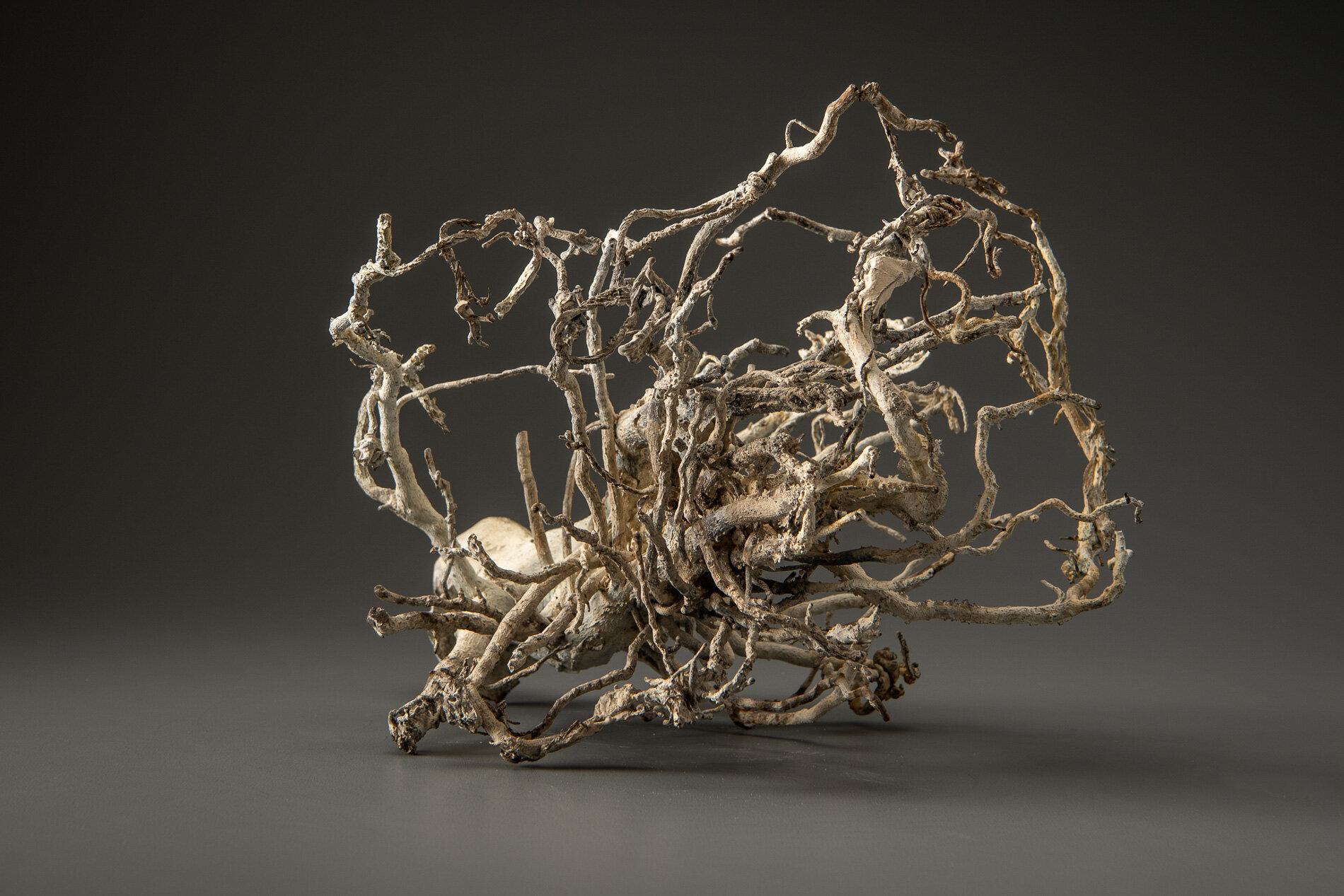Front legs and right shoulder
Endangered Knowledge: The Soul of Humus
20’ more of rebar.
I used 20’ more of rebar today to build the hip bones up on both sides and his right side in the stomach area of his side. I worked from the hip to his shoulder.
My work space is not large enough to get a good side photo.
Endangered Knowledge: The Soul of Humus
Stomach, upper hip bones, and more hump.
He still looks like a hybrid giraffe bison, that is only because his muscles and fur come later.
Endangered Knowledge: The Soul of Humus
Another big day of welding..I added a big 96” circumference chest. Put the entire piece on four dollies and started his hump. Below are a few pics from todays work.
Behind my garage is a telephone pole. I use it to bend my rebar. This is a side view where I am going to bend the piece for the chest.
Halfway to becoming a bison chest.
Then I use my weight to even out the shape.
I hang the chest over the back and decide if it is big enough.
Next I weld the ends together .
Recycling some old dollies from past work and deciding on the best plan. Balance and portability is the goal. The brown paper is the footprint of my bisons. Each leg is supported by a dollie.
Thanks to Curtis for getting me the plywood and helping me mount the beast. This is just for while I work on the sculpture and for transportation. It is not part of the work.
Just goofing around
My garage studio assistant is taking a sun break.
Starting to assemble the hump.
And that's a wrap.
Endangered Knowledge: The Soul of Humus
July 5th.
Attaching the head—
I welded just one connection from the neck to the head. As I assemble other parts of his body I will continue to evaluate the position of the head. I want him to be his reaching to the side searching for the next blades of grass within the reach of his massive head and tongue. With only one weld I can easily cut it off if I decide it is not in the right place or at the right angle. I do enjoy having a bobblehead bison in my garage for a while.
Building the girt—
I happened to have a circular scrap piece of rebar almost the right size. I created it years ago to be a round seat for a faux bois chair that was started and not finished. I turned it into the basis for the bison’s rear hip girth/stomach.
It is a little small, the small size gives me the flexibility to add to it exactly where I want it to protrude. As I get more elements worked out I will make it larger by adding the back hip bones that protrude. t is a lot easier to add pieces as I build him than to cut out pieces.
1 small tack world neck to head. Just to see where I want it.
Endangered knowledge:The Soul of Humus
I dried some cosmos leaves to us as the coat of a sculpture that is in the works - Endangered knowledge: the Soul of Humus. The piece will be in the #sculpturemonthhouston 2021 exhibit. I started the armature during COVID for the SMH 2020 exhibit, which was postponed. The sculpture looks at the ecological history of the coastal prairie. This texture is perfect #cindeeklementart #endangeredknowledge #coastalprairie #tezasart #houstonart #bioart #environmentalart #cosmos #art #sculpture #bison
Root to Water- when science backs your art -Art that looks at science with a critical eye.
"It is clear that the past offers a vast repertoire of cultural knowledge that we cannot ignore," highlights Professor Boivin.
It is a different way to think of things; however they are on the right root. I have a feeling there will be more areas Root to Water intersects science.
ROOT TO WATER
12” X 18” X 12”
found objects: rusted steel irrigation wheel, root
photo by Nash Bake
Spontaneity and art - a good thing, we will see
I started my day at 6:30 am, pasting images of work into a word document for a curator/art consultant. A necessary task that I was thrilled to do- however, mind-numbing, to say the least. By 12:30 crossed eyed I took the dogs on a walk. When I came across this. My mind numbing was instantly healed with inspirational thoughts.
Seven immaculately bundled trimmings from a neighbors Crape, Myrtle. Crape murdered or not I- the trees were in the backyard, could not see them.
My trimmings from a site-specific installation @Lawndale Center for the Arts. Symbiosis
The image above is from last week at Lawndale (a post in am tardy with) My trimmings are wild and unruly. I am using them on social media to make a point - to change how we landscape- to landscape with habitat for wildlife in mind.
My neighbor's bundles of limbs are in sharp contrast to mine. They are an example of how controlling urban green spaces have become, the tidiness that is expected In our yards.
I am so tempted——— Such a great opportunity to turn these found object organic materials, perfectly assembled tied up with yellow cords into gorilla art. The colors will look amazing at Lawndale. It is not part of my work on Symbiosis to install anything I want. 🤔 The entire dog walk I was haunted by the bundles and their yellow cords. I am not comfortable installing gorilla art but I am excited with the idea and I know Lawndale won’t have me arrested like other institutions might if I randomly installed objects in their sculpture garden, right?
I have always challenged myself to take on the art that scares me the most- to embrace the butterflies as my son tells me. You don’t know until you try. - jump
I went to the door, I was hoping no one was home, Abby was a new neighbor and I introduced myself. - she moved in during Covid. We had a nice chat and she welcomed me to take her piles.
It took two trips
😁 when I bring new materials to Lawndale, I like to photograph them on this turquoise wall- documenting my materials. And I have to say! I love the colors - the Textures.
I declare this installation number 1. Untitled.
This technically is not Lawndale property, the wall is theirs, but the lot is unfortunately not owned by the institution. The lot is vacant. I get all the bundles out so I can pick up load number 2.
Installation number 2
Installation number 3
The yellow ties make my heart sing, that rich brown against the turquoise, and the golden grass softening the base, I am in heaven. I see ballerinas chins up, lined up to take their bows center stage. I had one left.
A painter from last week left their yellow roller- waste not want not. The clippings Are rich on the violet too.
Sometimes I feel guilty that I love my work so much.
There are bees that have not been seen since the 60’s that are not listed as endangered.
After reading the document that listed Bombus Affinis as an endangered species I formed my own opinion by and it does not reflect well on the chemical industry.
Bombus Affinis - the rusty patch bumble bee
Turning back the evolutionary clock evolution in urban neighborhoods
4" X 13" X 8"
bronze
photo by Nash Baker
The sidewalks in my neighborhood are my nature trail. I walk with my eyes on the prowl for intriguing insects, exoskeletons, insect wings, feathers, dried flowers, twigs, leaves, seeds, and pods — things my children’s eyes taught me to find during our walks together over the years. Since 2013, these biological mementos have found their way into my bronze work in the molds of nests. Each piece is a reflection of that year’s ecology and records the time and movement of environmental restoration.
Initially, I was unaware of the landscape around me, but as my art dove deeper into environmental restoration and Hurricane Harvey changed our city, I realized that my days are, in fact, full of sterile surfaces. With COVID-19 quarantine, children in my neighborhood started venturing outside and looking for things to capture their curiosity. Delighted with their new interest, I realized that the green spaces and puddles children explore now are no longer filled with a diversity of life; the box turtles, bullfrogs, tadpoles, bumblebees, and assortments of flitting insects have evaporated with the spray of insecticides and herbicides in our neighborhoods. The selection is reduced to cicadas, the common beetle, honeybees, a rare native bee, and an abundance of Cuban lizards that dwell in turf grasses, boxwoods, crepe myrtles and oaks. I have awakened to cultural landscape uniformity. COVID has changed how I see the need for perfect lawns; the dirty truth is mosquito home-misting machines, obsessive weed control, artificial turf and a lack of plant diversity have turned urban neighborhoods into manicured monocultures for humans exploring video games. These habitat changes in massive population centers are fast-forwarding evolution: loss of wildlife habitat is one of the biggest threats facing many animal species. This does not have to be—it is a societal choice, the ability to speed up evolution can go both ways. Through my works – Lawndale’s Symbiosis, Endangered Knowledge: The Soul of Humus, Gust, World of Hum, Rumblings and Root to Water—I am committed to creating work that educates and helps communities change how we landscape our cities to include valuing the natural world and turning back evolution.
In Dirt to Soil, Gabe Brown quotes Don Campbell, “If you want to make small changes, change how you do things, if you want to make big changes change how you see.” When I come across intriguing flora or fauna on my urban trail, albeit few and far between, I see them as evidence that can inspire a revolution in the landscape. If they are expired and will not decompose, I collect them. I see these bronze cast nests as urban wildlife fossils—biographies, every year a chapter recording Houston's environmental awakening. As an optimist—environmental—art—activist my work focuses on revealing endangered knowledge to change how we see urban landscapes and activate cooling the planet through our cityscapes. As migratory birds return year after year to build nests and raise their young, I return with optimism in my step. I envision witnessing the return of four hundred plus butterfly species and eight hundred bee species native to Texas. I can see this returned wildlife capturing my future grandkids' imaginations. I will tell them the story of how insects almost disappeared and how every yard is a micro-ecosystem and matters. I imagine their hands building nests with a diversity that I cannot imagine. I hear their voices telling me in one breath about the fuzziest-biggest bee they ever saw, covered in golden dust nesting in a patch of ground beneath the sunflowers not far from the silverleaf nightshade. I see them bringing me a tail-feather from a Red Shoulder Hawk and asking, "what does it hunt" and is it the bird that sounds like the squirrel's screech. After a rain, I see them finding two bullfrogs attached and their tiny ribbons of floating eggs in a pond. I hear them tell me not to touch the caterpillar of the southern flannel moth, and asking me, “how does it sting?”. At the low of evening when dragonflies hover; I will watch as they study the night heron’s quiet solitary stance as it stalks small citizens of the grass, I will smile as they question the raucous warnings of ravens and the scoldings of nut collecting squirrels. I will feel their excitement when neighborhood raccoons appear from storm sewers and scavenge treats from dog bowls and opossums waddle fence lines, searching out grubs and open garage doors. I will follow their eyes when the silent patrol of the lone coyote visits the shadows of our boulevards from their bayou bound dens. I let them sleep outside and hear their heavy eyelids ask, why do the owls ask who? I listen as they wake up to a concert of white-winged doves. I will feel peace when they are wise to nature.
Lawndale Art Center - symbiosis
In a nutshell, this is what I hope to achieve with my site-specific piece, Symbiosis.
I am rethinking the uses of yard clippings.
Lawndale - Symbiosis - extractive
In Symbiosis I am stretching my practice and creating a living piece of site-specific art activism that will reimagine a 53.5’ X 48’ traditional urban landscape/sculpture garden and answer the question: how do we holistically restore an ecological balance in Houston? Symbiosis is a collaboration with Lawndale Art Center’s community, neighbors, urban wildlife, and the coastal prairies carbon cycle.
The west border of the garden has five 1 1/2 year old Crepe Myrtle’s a tree famous for murder. The murder refers to badly pruning the tree- down to the knuckles. I was not having these Crape Myrtle’s murdered. Today I used a extractive method of sculpting and clipped- nipped - and cut the existing branches. I shaped the branches/armature of the two end trees.
A sculpture garden has the four seasons of the year and a sculpture garden has the additional change of exhibitions. The pedestals from the last exhibit were still in the garden. 🤔perfect way to highlight the beauty in the wild- the imperfect- the not immaculate urban landscape.
FYI- crepe Myrtle’s are not native however they are a cherished gift to the Art Center. As an optimistic art activist I look at the project holistically to include the desires of the Art Centers board.
When I work in wire, or steele if I cut too much I can always weld it back it add more wire they are forgiving materials. When I clip a branch it is gone- no second chance. .
#artactivism #cindeeklementart #symbiosis #lawndaleartcenter #nativeplants #coastalprairie #sculpture
Create Myrtle cuttings wildly place on a pedestal.
North West Crepe Myrtle after pruning.
Cuttings from two Crepe Myrtle's and the olive trees from a few weeks ago.
South end Crepe Myrtle
Lawndale’s Symbiosis - constant research
Symbiosis is a long term art installation. A piece of dirt in the middle of a large US city, an ecosystem that serves the local art community. Through pairing my intuitive sculptural practice, and natural history research I am sculpting the garden into an ecosystem that balances the needs of the Homo sapien art community and the urban natural world. I spend much of my time filtering through biologist research, inspirational documentaries and interviews of individuals that are leading the way. New Year’s Day I listened to a remarkable podcast an interview of Nora Bateson who is an award-winning filmmaker, writer and educator, The podcast was taped before the pandemic. She knows what she is talking about. Here are two quotes from the podcast that gave me pause and reminded me how grateful I am for my opportunity to make a difference through Symbiosis at Lawndale
“ In my little fantasy there is a great big pause button, and we can say hold everything, let’s regroup, let's turn this titanic around”
“One way or another the systems that we are within are going to change.”
A very enlightening podcast regarding how change and regeneration happens. It is haunting to consider this came out before the Covid 19 quarantine of 2020. Everything Nora talks about addresses the things I am thinking about. She is most definitely an influencer. I will continue to follow and monitor her work.
You can find the interview at The Regenarration podcast on Soundcloud Solve Everything at once.
Checking on the garden I found a moth that was still alive laying in the Pond. I rescued him and laid him out to dry.
Subterraneous Secrets - how plant roots communicate with microorganisms
Army Corps of Engineers study
The Army Corps of Engineers study to reduce flooding risk does not consider utilizing any nature-based solutions. Here is a fascinating discussion of nature-based solutions that will not cost $1 -$12 billion.
“How fleeting are the wishes and efforts of man! How short his time! and consequently how poor will his products be, compared with those accumulated by Nature during whole geological periods.”
—Charles Darwin, Origin of the Species
I was already working on this piece and the artist/activist/conservationist statement that it visually supports. I am excited to get it photographed and out to the public. There is no question that Charles Darwin had it right. Before we spend $12 billion and wreck the Katy Prairie and Buffalo Bayou let’s review a study by bioengineeers.
World of Hum- a humdinger
Keystones in El Paso
50” x 10’
watercolor monotype
Subterranous secrets
Once I started researching roots, I was in love. They have many cool features as a group and individually. I have three bronze roots completed and a few more in the works. Many scientific labs study root characteristics for their role in food production. I am interested in these conversations and those that discuss the roots architecture. Under recognized for their amazing features roots bring many values to the table. They are a tool that sequesters carbon, transports water deep into the soil and pumps it up Into the plant. They inhibit erosion and are the heart and vascular system of the planet. And that is just a start.
Lawndale Art Center — Symbiosis environmental art activism project announced
Lawndale Art Center a staple on my radar as a possible venue for an environmental art exhibition. The sculpture garden, primed to be relandscaped in a manner that could communicate any number of environmental issues in my head.
The Lawndale Art Center Sculpture garden before the 2019 re-landscape.
I have had a few casual discussions with Stephanie about these ideas in the past, however other opportunities came my way, and frankly, I dropped the ball.
During the first COVID 19 quarantine, Lawndale Art Center reached out to me regarding their sculpture garden. They were interested to know if I would assist them with some weeding in their newly landscaped sculpture garden, I often volunteer there. When I heard the words, “newly landscaped sculpture garden,” my heart fell to the ground. I had blown it, I missed the best art venue opportunity to create a piece that looks at urban landscape as a found object. I was crushed, disappointed and angry at myself. I decided to focus on my Endangered Knowledge: The Soul of Humus, a piece I am creating for Sculpture Month Houston. In turning Lawndale down I sent them a copy of the proposal I made to SMH. A few days later I remember thinking to myself, “well you blew that opportunity, you will never get a show at Lawndale now.” A few weeks after that— they called me back and asked me to meet them at the sculpture garden. Masked I met with Stephanie and Emily and they asked me to do a site-specific environmental piece in the newly relandscaped garden. It was the last thing I expected—A dream come true was not in my mind of possible COVID19 realities. We also discussed their need for some happiness in the garden. The garden does not have any beneficials planted. Sympathetic to their need for some visual happiness I offered to plant a few flowers.
By this time it is unbearable—Houston—July—Hot.
What can you plant in July and have it not fry, if anything? I am not an experienced gardener I am an artist/activist and a citizen environmentalist—but my friend and past President of the Harris County Master Gardeners, artist, and curator is a very knowledgable gardener. A super busy Renassaince man, Will Isbell kindly offered to meet me on a Friday evening at the garden to see if there was anything I could plant that would not die in this July heat. There was not, but we did have a great talk.
We both saw the existing garden in the same way a missed opportunity for an environmental artist. And then it hit me. I suggested that I propose to Lawndale that the two of us do a project that takes the existing new traditional landscaped garden and use it as a found object to create a piece to activate change in Houston’s landscape. Will did not hesitate.
The question was how do I get them on board. They have already spent good money and the garden by any standards is beautifully done. One thing everyone knows about Lawndale, it is an art space for the voices of artists breaking boundaries and unearthing contemporary knowledge, nothing is too daring for Lawndale. They are the space in Houston to open minds. They were encouraging and interested in this new idea and wanted me to continue working on a concept for a solo environmental piece as well the piece with Will.
I am still num with these two opportunities and excited with the potential to instill hope and heal the environment.
Lawndale announced the project Will and I are doing together last week. Below is the proposal for the work. I wrote it in early July, as I read the opening paragraph today, with California on fire, and Houston flooding again I am taken back by how much the world has changed since I wrote it.— and not in a good way.
Lawndale Sculpture Garden Proposal
Cindee Travis Klement and William Isbell
What is to be gained in the year 2020, the year of perfect vision? In our largest cities, a tiny virus is killing our most vulnerable, crippling our strongest economies, forcing our families into food lines, and providing kindling for social reform protests. In the natural world tucked within our largest cities, this same tiny virus has improved the air that we breathe, returned fireflies to our summer nights, and allowed wildlife to inhabit our neighborhoods. The connection between the land, plants, mankind, and wildlife in urban environments has never been more evident.
What is to be gained in the COVID 19 moment of enlightenment: our eyes have opened to the state of our living systems, and we have discovered that unimaginable change is possible. We have seen that we cannot wait for the tests to tell us if we are sick. Without design, we have found an unprecedented moment, we have gained an opportunity to change.
SYMBIOSIS
As visual artists and art activists, we will connect soil health and the health of our city. We will create a living piece of site-specific art activism that will reimagine the urban landscape and answer the question — how do we holistically restore an ecological balance that can coexist in Houston with nature/ wildlife through sculpture and community involvement. We see the Mary E. Bawden Sculpture Garden's terrain with its manicured, status quo landscape as our found object. With ordinary tools, organic matter, with the help of the community, we will sculpt it into the armor that historically protected Houston’s geological epidermis and gave life to its keystone species — the Coastal Prairie ecosystem. The title of this found object sculpture is Symbiosis. Over time Symbiosis we will morph into not only a landscape but also a soundscape that changes kinetically with the seasons.
Lawndale’s Mary E. Bawden Sculpture Garden’s Symbiosis will be a catalyst for change. In addition, it will be functional as a contemporary art exhibition space, a piece of functional activist art as well as a healthy ecosystem/habitat: a sculpture garden that heals and honors the history of the land.
Physical Description of Piece
Once the parameters of the project more are specifically defined we will insert the specific plants, their ecological roll in the
design and define the work.
Environmental Impact
Soil scientists around the globe agree that solutions to global warming, soil erosion, water runoff, drought/flooding, loss of wildlife habitats, and species extinction are rooted in the treatment of our soil — the skin that covers our planet, which includes our residential and small business landscapes.
Restoring the native prairie vegetation increases soil absorption of water and slows floodwaters on land, decreasing water runoff. For every 1% increase per acre of biological organic material, the soil can hold an additional 20,000 gallons of water. Given Houston’s extreme building practices and concrete hardscaping, reimagining the landscapes within Houston's 600 square miles of real estate can significantly impact the region's flooding. In addition, the roots of vegetation in a coastal prairie can extend from eight to fourteen feet deep; these roots sequester and store carbon like an upside-down rainforest, cleaning our air.
Value of Location
Change can happen at lightning speed when innovation is coupled with imitation.
The current state of Lawndale's sculpture garden provides the perfect opportunity to break the mindless conformity that dominates Houston's urban gardens/yards. The sculpture garden has the feel of a perfectly manicured, traditional front yard, making its size and plant selections relatable to the general public.
With the Houston Arboretum transformations, Katy Prairie Conservancy, Buffalo Bayou, and the new Memorial Park renovation, Houstonians have awakened to the importance of native Coastal Prairie landscaping; however, those sites are enormous tracts of land. It isn't easy to visualize those landscapes outside the parks. This permanent and living metamorphosis of Lawndale’s Symbiosis will provide the 2020 vision of transformation by imitation for yards throughout Houston. It will shift mindsets by prompting Houstonians to question Houston’s urban landscaping and imagine a holistic Houston that protects the environment by balancing human, natural and economic systems.
Value for Lawndale Art Center
An art institution that looks at its community holistically to include not just a monoculture of humans but also beneficial plants, animals, and micro-organisms will be groundbreaking. Symbiosis will cultivate a medley of life that historically has defined the place, has impacted its economy and attracted its people. Lawndale’s Symbiosis will leverage this endangered knowledge with a living site-specific art installation that provides the artistic vision that changes hearts and minds. It will connect the history of the land to contemporary art. Using additive and subtractive sculpting techniques and nature the Symbiosis of the Mary E. Bawden sculpture garden will become a living love letter from our past to our future.
Ecological impact of Houston
With 2.3 million people living on a footprint of 600 square miles, close to the Gulf of Mexico, located along the migratory bird pathway, Houston is an urban wildlife sanctuary.
Changing Houston's ecology will profoundly impact our oceans, human life, wildlife, and microbial environmental health. Let’s not miss this unprecedented opportunity and heal the skin of the planet and our people.
Installation Process
The beauty of this piece is to have it be a catalyst for inspiring homeowners and businesses to imitate the change and heal their landscapes too. We will Involve the community to take on an active role in the transformation. Installation of the piece will engage and educate the community in ways to be defined after specifics of the piece are worked out.
Lawndale after one of our early Symbiosis meetings.
Beautiful new fence and Jasmine and crepe Myrtles.
Olive trees, African Iris, Dwarf Yupon Holly, Gardenias, Asian Jasmine, Crepe Myrtles -6 very popular landscape elements across Houston.
Will’s and my found object — Lawndale Art Center, Mary E. Bawden Sculpture Garden
Why soil?
“The soil is the creative material of most of the needs of life. Creation starts with a handful of dust.” - Dr. W. A. Albrecht ph. D.
That is a powerful thought. How important is soil to our health? For me it is clear.
And it is not dirt, it is not clay, it is humus living soil.
This quote is deeply tied to all of my current work, in The Endangered Knowledge piece that I am in the early stages of welding soil is the material that will become the protective layer of the keystone species, in Subterraneous Secrets soils energy is stabilized and captured through root systems, in Mute Testimony, it records its history, in Gust the life it provides is Endangered. In the photography of life in my cement pond, it establishes natural rhythms and compliments the other living systems. The pond is a complete ecosystem; it is free of pesticides and herbicides. In this type of ecosystem, even the blooms in their last phase of life are beautiful as the tiny microorganisms convert them back into minerals that build soil health. #inmycementpond In this image, you can not see the humus, but you can see the magic in the life it brings when we allow it to thrive in a natural state.
Endangered knowledge: The Soul of Humus #17 Cowbirds
I just read an intesting article; how Cowbirds are hedging their bets when choosing surrogate birds to hatch and raise their young. Another instance that supports the theory that diversity is the ticket when it comes to the survival of a species.
Coincidently I picked up the bronze Cowbirds yesterday. They are ready for me to recreate the texture where they were damaged during the spruing process. Once that is complete I will deal with their patina. I should wait and decide on their finish once the abstract bison is further developed. That said I am excited to see how the materials will look in a polished finish. Below are closeups of each bird - just for the record.
The finishes are very powdery looking and flat because they were just sandblasted. When I decide on the patiba the textures will really show up.
I took a risk when I decided on the manner in which I would create the birds. The Cowbirds are constructed in a primitive manner. And they look extra primitive laying on the faux bois chair. Context impacts the way we see. I feel hopeful the organic and rough construction will work on the abstract beast they will be attached to. Roughly constructed they support the story, polished perfectly detailed birds would not relay their connection to the geography and mammals. I realize I have not taken the safe root and hope I didn’t need to hedge my by as the Cowbirds did theirs.
The big bird side 1
Opposite side.
On this image you can see a smooth surface from where the sprue was cur off. One spots the I will retexture.
From the top
Bird 2
Bird 3
Derail shot of bird 3 - you can see the seeds and grass stems.
Bird 4
As I recall this one gas some bluebonbet seeds in it's back feathers.
Bird 5
Texture gives me good goosebumps.

